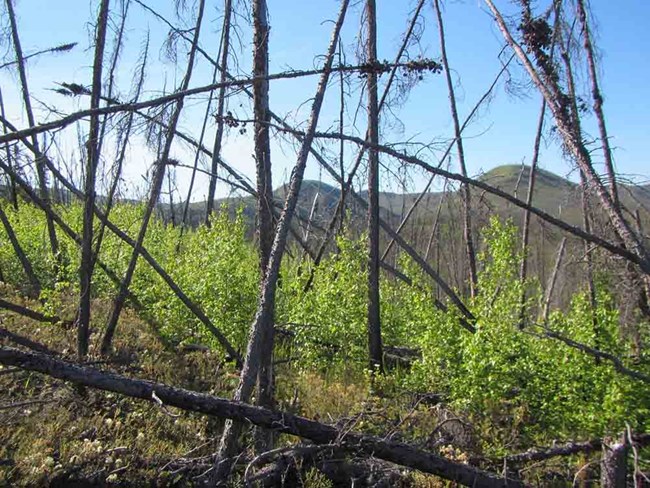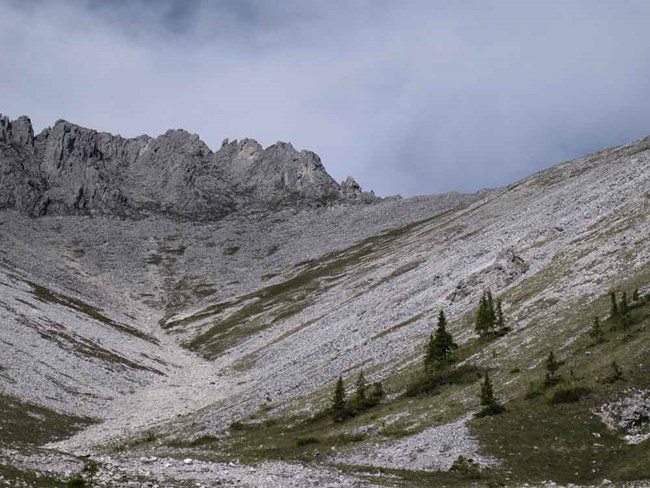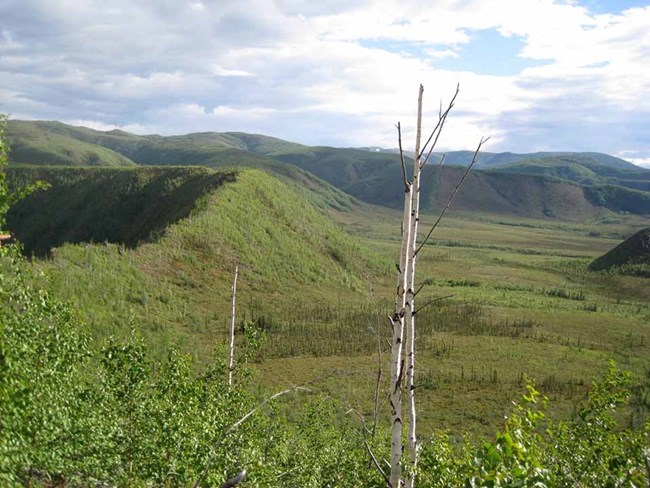Last updated: December 30, 2019
Article
Fire, Topography, and Climate Drive Variation in Alaska's Boreal Forests

High-latitude regions are warming rapidly, with major ecological consequences. To better understand the likely changes in Alaska's boreal forests, we compared forest survey data from Denali National Park and Preserve and Yukon-Charley Rivers National Preserve. These two areas differ with respect to relative summer warmth and the history of fire disturbance offering a useful “natural experiment” to consider these issues. Our results confirmed several of our hypotheses, such as increases in broadleaved species in warmer, more fire-affected locations. However, contrary to our predictions, we found no evidence of reduced frequency of conifer species or increases in non-fire-related mortality as suggested by recent literature. Instead, spruce species occurred widely even in warmer, more fire-influenced areas except under the most extreme conditions (very steep, south-facing slopes) in Yukon-Charley.
Based on our results, We expect that changes in tree distribution and forest structure in interior Alaska will proceed unevenly, depending on terrain local conditions (slope, aspect, elevation) and species (forest composition and species dominance) will change according to differences in their surrounding landscape (such as fire disturbance, variation in soil temperature, and other attributes).
Our results do not suggest an ongoing biome shift resulting in diminished boreal forest cover in the short to medium term. Rather, our data indicate that cooler areas of Alaska's interior may support modest increases in forest cover as warming continues, until warming and fire disturbance become more extreme than the conditions captured by our “natural experiment."
Photo Gallery
The following photo gallery of images was published in:
Roland, Carl A., Joshua H. Schmidt, Samantha G. Winder, Sarah E. Stehn, and E. Fleur Nicklen. 2019. Regional variation in interior Alaskan boreal forests is driven by fire disturbance, topography, and climate. Ecological Society of America Bulletin 100(3):e01566

NPS/Gwen Schneider
Young birch trees (Betula neoalaskana) recruited following a fire that killed an open black spruce (Picea mariana) canopy in Yukon-Charley Rivers National Preserve, Alaska. We found that the abundance and occupancy of birch (and other broadleaved tree species) were considerably higher in the more fire‐affected study area as compared to Denali National Park and Preserve.

NPS/Rachel King
This photograph shows the subalpine landscape of Godge Creek in the Charley River watershed, where permafrost (which underlies the sedge‐ericaceous community in the foreground) exerts strong controls over the distribution and abundance of tree species in both of our study areas. Areas with only shallow seasonally thawed layers, such as the site shown here support few, if any, trees in part due to cold, poorly drained soil conditions. The stands of trees in the background are white spruce (Picea glauca) growing in less solidly frozen terrain with higher solar radiation receipts. A warming climate is thawing permafrost in subarctic Alaska, likely initiating far‐reaching ecological changes.

NPS/Haig Diradourian
This photo, taken from near the top of Kathul Mountain, shows the warm, south‐exposed lower slopes of this feature rising from a terrace of the Yukon River (seen in the background), Alaska. The vegetation mosaic seen here is affected by dramatic variation in solar radiation, soil moisture, and fluvial disturbance processes. The tan and buff‐colored open slopes in the foreground support subarctic steppe vegetation which occurs in steep, south‐facing slopes too warm and dry to support trees (in Yukon-Charley Rivers National Preserve, but not in Denali National Park and Preserve) and grades into neighboring open aspen forest. The deeper green boreal forest in the background is productive mixed white spruce–birch forest on deeply thawed well‐drained river terraces common in both study areas. The vibrant green open areas on the terrace support open meadow and scrub vegetation in areas too poorly‐drained, acidic, and/or cold to support vigorous tree growth.

NPS/Benjamin Hart
This photo shows limestone barrens in upper Funnel Creek watershed in the Ogilvie Mountains of Yukon-Charley Rivers National Preserve, Alaska, supporting widely scattered white spruce (Picea glauca) trees near the very upper elevation limit for trees in this region. We found that trees were much more common in considerably higher elevations in the Yukon-Charley study area as compared to Denali National Park and Preserve (even though it lies ~2° latitude farther north). This difference in the position of treeline is likely due (at least in part) to the warmer growing seasons, considering the higher continentality in this region. Also, white spruce shows a marked preference for less acidic soils, such as those formed from limestone rock seen here.

NPS/Erin Corrigan
This photo shows a mosaic of forest types occurring in a remote section of the upper Kandik River drainage near Johnson Gorge in Yukon-Charley Rivers National Preserve, Alaska. A legacy of forest fires (which allowed the recruitment of early‐successional cohorts of young birch in the foreground and on the hillside at left) along with topographic variation (affecting solar exposure, site drainage) and fluvial disturbance are important factors driving the landscape‐level patterns in forest structure in this region. Permafrost, which underlies the open black spruce woodland in the center of the photo, is also influenced by these landscape factors, and has important interactions with vegetation cover. The thawing of permafrost with rapid warming will profoundly affect the distribution and function of subarctic ecosystems in the coming decades.
Regional variation in interior Alaskan boreal forests is driven by fire disturbance, topography, and climate
Abstract
High-latitude regions are warming rapidly with important ecological and societal consequences. Utilizing two landscape‐scale data sets from interior Alaska, we compared patterns in forest structure in two regions with differing fire disturbance, topography, and summer climate norms. Our goal was to evaluate a set of hypotheses concerning possible warming‐driven changes in forest structure suggested by recent literature. We found essentially consistent habitat associations for the tree flora across two disparate study areas concomitant with considerable differences in observed patterns of forest structure and composition. Our results confirmed expected increases in broadleaved species occupancy and abundance in the warmer, more fire‐affected study region along with considerably higher tree occupancy and abundance in high-elevation areas there. However, contrary to our predictions, we found no evidence of expected reductions in conifer occupancy or increases in non‐fire-related tree mortality. Instead, both individual and combined tree species occupancy, density, abundance, and richness were considerably higher in the warmer, more fire‐influenced region, except in the warmest, driest areas (steep and south‐facing slopes at low elevation). Our comparison of two landscape‐scale data sets suggests that changes in tree distribution and forest structure in interior Alaska will proceed unevenly, governed by a mosaic of site‐dependent influences wherein forest community composition and species dominance will shift along different trajectories and at different rates according to variation in underlying landscape attributes. Although there were clear differences in forest structure between the two areas that were likely attributable to differences in growing season warmth and fire disturbance, we found scant support for the concept of an incipient, ongoing biome shift in interior Alaska resulting from impending diminution of boreal forest cover over the short to medium term. Indeed, we suggest that (depending on severity of disturbance dynamics and the rapidity of future warming) cooler areas of interior Alaska's forest may reasonably be expected to sustain marginal increases in forest cover with additional warming, at least in certain topographic positions (such as poorly drained basins and cool treeline sites) and/or geographic regions, prior to any landscape‐scale diminution of forest cover due to warming.
Roland, Carl A., Joshua H. Schmidt, Samantha G. Winder, Sarah E. Stehn, and E. Fleur Nicklen. 2019. Regional variation in interior Alaskan boreal forests is driven by fire disturbance, topography, and climate. Ecological Monographs https://doi.org/10.1002/ecm.1369
